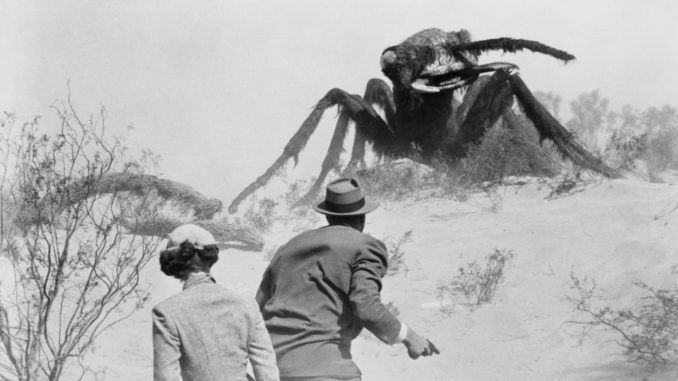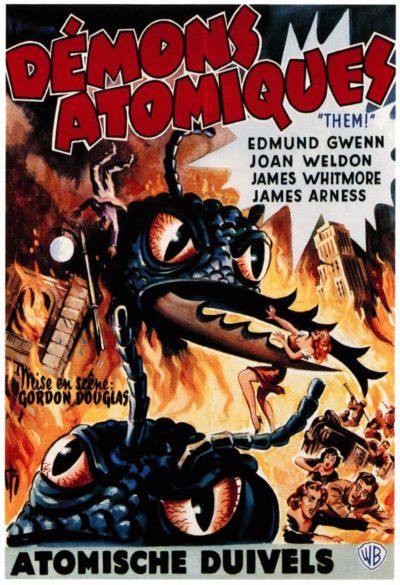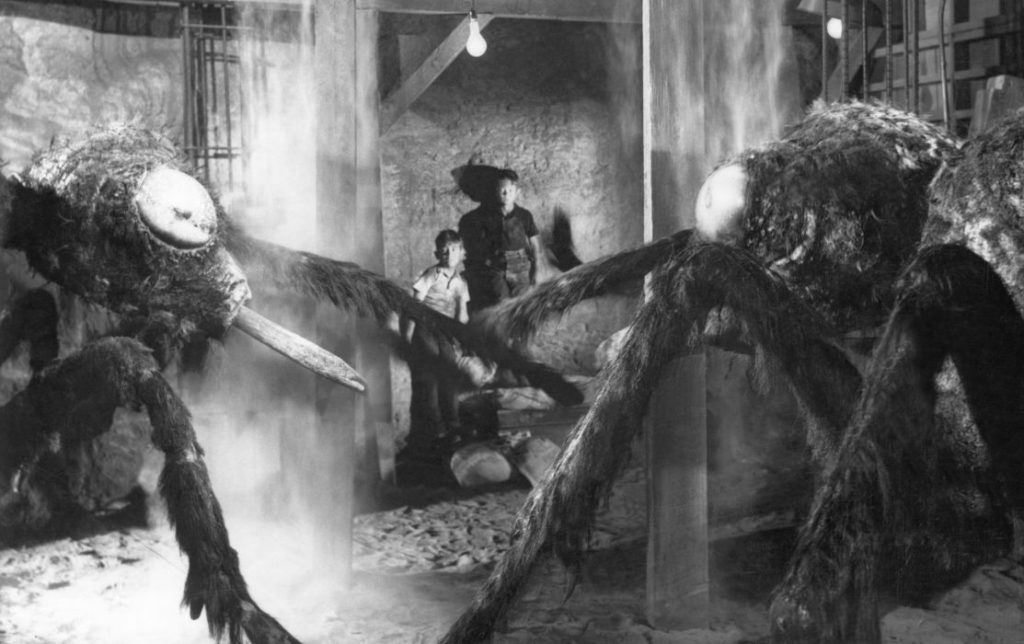
Rating: B
Dir: Gordon Douglas
Star: James Whitmore, Edmund Gwenn, Joan Weldon, James Arness
1954 is one of only two years in this feature where we had already reviewed the film suggested by our algorithm, and needed to find a replacement. The initial selection was Godzilla, written about in March last year. But I did not have to look very far for a substitute, and this seems particularly appropriate as a stand-in, being similarly radiation-adjacent. In the fifties and sixties, the topic of radiation was more or less a blank slate, which artists could use for whatever purpose they wanted. Create zombies? Check. Turn people invisible? Check. Make someone turn into a super-strong green guy whenever they get angry? Hulk-sized check. It’s more or less how contemporary film-makers view AI as a subject: it’ll do whatever you need it to do for your story.
This one holds a special place in my heart, because it’s the first “scary” movie to have an impact on me. After seeing it on television, around the age of seven or eight, I was concerned giant ants were living in our attic. I would scurry past the stairs leading up to it, in case one would leap out, grab me in its pincers and drag me upstairs. Not helping matters, I imagine: the house was built in 1815, so noises at night were very much par for the course. Watching this now immediately triggers warm feeling of nostalgia for that simpler – albeit more irrationally terrifying – time. The other element which stands out here, is the film being undeniable evidence for the power of not seeing something.
 I generally am against the “use your imagination” school of horror. It feels like a lazy cop-out for film-makers, transferring the work onto the audience. If you have a creator with imagination, then whatever they can conceive is likely better than you could come up with. There was, admittedly, more justification for it in the fifties, when effects were more primitive. But I doubt there are many films with a bigger gap between the quality of the set-up, and the weakness of the monster delivery. Given the era, I can hardly blame Douglas, as this is almost unexplored territory for special effects. While it’s painfully obvious they have not aged well, I’d be interested to know if contemporary audiences and reviewers found the results convincing. Seems they probably did: though no effects personnel were credited on-screen, it was Oscar-nominated, but lost to 20,000 Leagues Under the Sea.
I generally am against the “use your imagination” school of horror. It feels like a lazy cop-out for film-makers, transferring the work onto the audience. If you have a creator with imagination, then whatever they can conceive is likely better than you could come up with. There was, admittedly, more justification for it in the fifties, when effects were more primitive. But I doubt there are many films with a bigger gap between the quality of the set-up, and the weakness of the monster delivery. Given the era, I can hardly blame Douglas, as this is almost unexplored territory for special effects. While it’s painfully obvious they have not aged well, I’d be interested to know if contemporary audiences and reviewers found the results convincing. Seems they probably did: though no effects personnel were credited on-screen, it was Oscar-nominated, but lost to 20,000 Leagues Under the Sea.
Kinda amusing to see Arness, three years after playing The Thing From Another World – we’ll be covering that in a few days – and Gwenn, Kris Kringle from Miracle on 34th Street, which we will not be covering. Leonard Nimoy also has a bit part, as an Army staff sergeant. I noted in my original review (below), how chill the population are when martial law is declared – as well as the government monitoring communications, and locking up those with inconvenient opinions regarding the existence of giant ants. All this is additionally anachronistic now, in the light of the COVID-19 schism. If such a scenario were to play out today, I imagine half the country would demand immediate nuking, while the other half would consider giant ants vastly overrated and proceed as normal.
The first thirty minutes are a masterclass in creating tension and unease, through inexplicable events. A trailer ripped apart. Stolen sugar. And what is that weird, chittering sound? Once we see the cause, the gloves come off, and it becomes a race to contain the threat while this is still possible. Douglas does such a good job, it’s a surprise there’s nothing as renowned in the rest of his filmography. Over forty-plus years, he directed a broad range of features, from Zombies on Broadway to Viva Knievel. However, to me, he’ll always be the man responsible for making a young Scottish boy afraid of the attic staircase.
This article is part of our October 2025 feature, 31 Days of Vintage Horror.
 [September 2015] Over 60 years old, yet still one of the best monster movies of all time – at least, for the first half. This is the kind of film they should be remaking, because I can only imagine how potentially terrifying this could be, if the pipe-cleaner and cheesecloth monsters eventually delivered, were replaced with some cutting-edge creations. They would, however, had to do well to capture the tense sense of menace generated during the early going, after New Mexico state trooper Ben Peterson (Whitmore) finds a young girl wandering, traumatized, in the middle of the desert, and her family’s trailer destroyed nearby, with unrecognizable prints in the sand.
[September 2015] Over 60 years old, yet still one of the best monster movies of all time – at least, for the first half. This is the kind of film they should be remaking, because I can only imagine how potentially terrifying this could be, if the pipe-cleaner and cheesecloth monsters eventually delivered, were replaced with some cutting-edge creations. They would, however, had to do well to capture the tense sense of menace generated during the early going, after New Mexico state trooper Ben Peterson (Whitmore) finds a young girl wandering, traumatized, in the middle of the desert, and her family’s trailer destroyed nearby, with unrecognizable prints in the sand.
Enter FBI agent Robert Graham (Arness), scientists Professor Medford (Gwenn) and his daughter Dr. Pat Medford (Weldon), the boffins eventually revealing the cause is giant ants, mutated by radiation from the recent atomic bomb tests in the desert. While this nest is destroyed, it’s not before two new queens escape; they must be located and destroyed, before they can spawn a fresh outbreak. And one appears to have taken up residence in the 700 miles of sewers that run beneath Los Angeles… The influence is clear, on everything from Aliens to Starship Troopers, but it’s equally as much a product of its time – there are times when the way the ants are described, they sound almost… Communist.
The Professor says ants “have an instinct and talent for industry, social organization and savagery, that makes man [in other words, 1950’s America] look feeble by comparison.” And it was also a time when the idea of martial law being declared in Los Angeles, and the resulting military takeover, could be portrayed as a good thing [compare and contrast the “Jade Helm” paranoia nonsense this year]. It has to be admitted, the film’s second half is less successful. This is partly down to the ropey nature of the special effects, which work better when they’re out of sight, yet it also becomes a bit more plodding and implausible [would even the kinder, gentler government of the fifties risk extermination of the human race to save two missing kids?], even forgetting the whole “inverse square” thing. Still, Douglas demonstrates a sure hand on the helm, and when set beside some of its contemporaries, this has stood the test of time a great deal better. B
